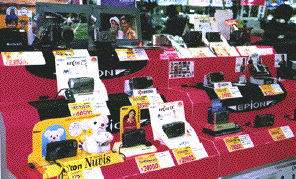ADVANCED PHOTO SYSTEM:
Jointly Developed Technology Gains Popularity
SEPTEMBER 25, 1996

Compact Size, Convenience a Hit
Cameras and film based on the new Advanced Photo System standard have been on the market for five months now. APS cameras and film cartridges are smaller than their conventional 35 mm counterparts, and users of the new technology enjoy the convenience of its simple film loading feature. Sales to date have been fairly good.
The APS standard was first proposed by an American company, which developed the technology over a five-year period in concert with four Japanese film and camera makers. The main feature of the five companies' new standard, announced on February 1, is the compactness of the 24 mm film cartridge. No film protrudes from the cartridge, 30% smaller than a 35 mm film case, making it easy to insert into a camera.
Approximately 3% of all 35 mm pictures are ruined due to faulty loading of the film. Upon insertion of a cartridge into a camera, however, APS film is automatically extended and placed in position for exposure, eliminating this worry from photography. But a camera made for the APS standard is necessary.
Exposed APS negatives remain in the film cartridge after development. The cartridge is returned to the customer along with an "index print," a contact sheet showing all the frames on the roll. Reprints of the photos can be ordered using this index print. The film cartridge itself displays one of four messages: "unused," "partially exposed" (film can be safely removed from and later reinserted into some APS cameras), "exposed," and "developed," eliminating the chance of double exposure.
Sales Fairly Good
As a rule, a 30% decrease in film size leads to a corresponding drop in image quality of enlarged prints, but APS film producers have developed a film based on new materials which they claim suffers no such loss of sharpness when compared to 35 mm film. In addition, information on photographic conditions, such as brightness, exposure time, and whether a flash was used is encoded on the film, allowing labs to adjust their processing techniques accordingly for each shot.
The film is sold in ISO speeds of 100, 200, and 400, and is available in rolls of 15, 25, or 40 prints. A 25-shot roll costs around 500 yen (4.50 U.S. dollars at the rate of 110 yen to the dollar), or about 100 yen more than comparable 35 mm film. APS-standard cameras are priced between 20,000 and 80,000 yen (180 and 730 dollars), again slightly more than similar 35 mm models.
But a growing circle of consumers are nonetheless recognizing the convenience and smaller size of the APS cameras. Recent buyers offered comments such as "It was time for a new camera, so I chose this handy little APS," and "This is a gift for my grandchild, so it needs to be easy to use."
According to industry representatives, APS cameras already account for over 30% of compact camera sales, and over 40% of disposable cameras shipped now use the APS standard. The companies are confidently revising sales projections, expecting to reach their goal of a 50% market share for APS before 2000, the previous target date.
Compared to camera and film sales, APS development and printing are seen as lagging. This is blamed on the high costs of the new technology; photo labs must obtain expensive new instruments to handle APS film and to take advantage of its features, such as recorded exposure information. Those labs that do install the equipment charge about 30% more for developing and printing, which take longer than for 35 mm film.
Japanese and U.S. Makers Cooperate to Create a New Market
The worldwide photography market is maturing rapidly, reaching the point of saturation. This has led to intense sales competition and price wars in the fields of cameras, film, developing and printing. APS producers hope to avoid the impact of this competition by opening a new market, and to compete with the digital still cameras currently gaining popularity. Digital cameras use removable memory cards or flash memory chips, rather than film, to store images, which can be downloaded directly into a personal computer for retouching or other alteration. APS producers plan to compete in this market with equipment that can digitize images directly from an APS cartridge.
American and Japanese film producers, currently embroiled in a dispute over market access, have joined forces to develop the APS standard, hoping to stimulate demand for this new product line. In this cooperation can be seen one instance of a real meshing of their desires.